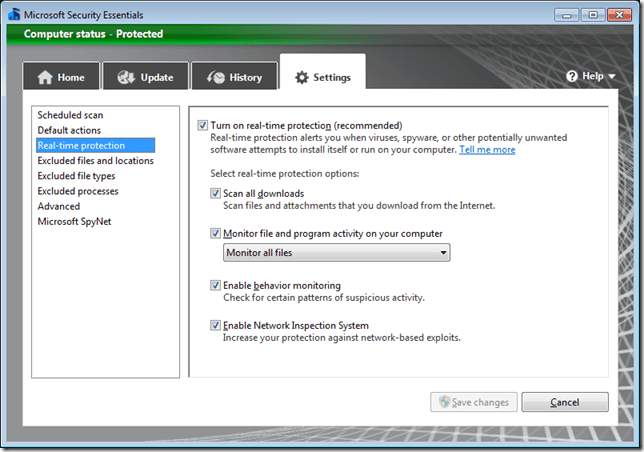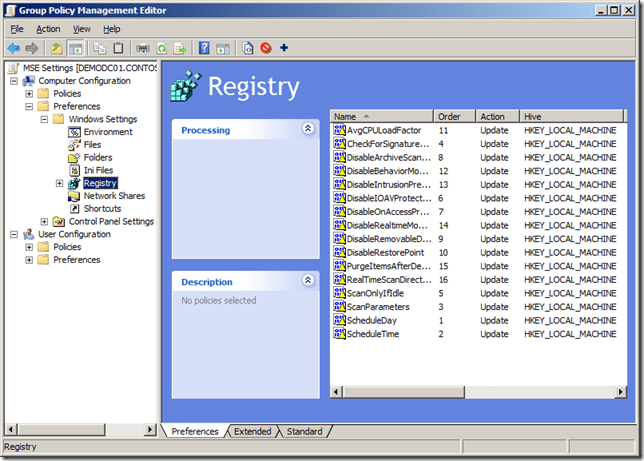Group Policy for Microsoft Security Essentials 2.0
 Microsoft have now released Microsoft Security Essentials 2.0 to the web which has a number of new features over the previous version.
Microsoft have now released Microsoft Security Essentials 2.0 to the web which has a number of new features over the previous version.
- Windows Firewall integration – During setup, Microsoft Security Essentials will now ask if you would like to turn the Windows Firewall on or off.
- Enhanced protection for web-based threats – Microsoft Security Essentials now integrates with Internet Explorer to provide protection against web-based threats.
- New protection engine – The updated anti-malware engine offers enhanced detection and cleanup capabilities with better performance.
- Network inspection system* – Protection against network-based exploits is now built in to Microsoft Security Essentials.
Therefore I have updated my previous post based Group Policy for Microsoft Security Essentials to support configuring the newly added features.
If you want more general info about MSE v2 see: Security Garden: Microsoft Security Essentials 2.0 Released
If you want to download it visit http://www.microsoft.com/downloads/en/details.aspx?FamilyID=e1605e70-9649-4a87-8532-33d813687a7f
Before I begin I should remind you that Microsoft only allows MSE to be used for free in small businesses with less that 10 seats (see here). But MSE does not natively support Group Policy and having to configured even 10 copies of Microsoft Security Essentials (MSE) manually can be a pain. So the instructions below is simply a way to configure the registry keys of the application using the Group Policy Preferences Registry key setting.
Tip: If the below instructions to create the registry keys seems like to much work you will be glad to know that I have put a link at the bottom to an XML Group Policy Preferences Registry file. You can use this file to import the all the Policy Registry setting I talk about below automatically.
How to use Group Policy Preferences Registry key setting.
Before we begin we first need to know how to create a Group Policy Preferences Registry Key setting that we will use to control each of the registry keys we need to configured MSE. The following steps will need to be repeated for each registry key below.
Step 1. Edit a Group Policy Object that is applied to the computers you want this setting applied.
Step 2. Navigate to Computer Configuration > Preferences > Windows Settings > Registry
Step 3. In the Menu click on Action > New > Registry Item
Now you know how to configure a registry key setting using Group Policy Preferences you can create a new Registry Item for each registry key listed below.
How to configured Scheduled Scan using Group Policy for Microsoft Security Essentials
Now you need to create a registry few specific registry keys. In this example we are going to configured a Full Scheduled scan to run each day at 8am. We are also going to enable the option to check for an update before scanning and we are going to configure the scan to
Scheduled Day
Key: HKLM\Software\Microsoft\Microsoft Antimalware\Scan
Value: ScheduleDay (REG_DWORD)
Data: 0 (Every Day)
Data: 1 (Sunday)
Data: 2 (Monday)
Data: 3 (Tuesday)
Data: 4 (Wednesday)
Data: 5 (Thursday)
Data: 6 (Friday)
Data: 7 (Saturday)
Scheduled Time
Key: HKLM\Software\Microsoft\Microsoft Antimalware\Scan
Value: ScheduleTime (REG_DWORD)
Data: 0 (12am)
Data: 000001e0 (8am)
The data of this value represents the number of minutes from 12am in hex… therefore if you want 8am configured the data to “000001e0”
Full or Quick Scan
Key: HKLM\Software\Microsoft\Microsoft Antimalware\Scan
Value: ScanParameters (REG_DWORD)
Data: 1 (Quick Scan)
Data: 2 (Full Scan)
Check for Update before scanning
Key: HKLM\Software\Microsoft\Microsoft Antimalware\Scan
Value: CheckForSignaturesBeforeRunningScan (REG_DWORD)
Data: 0 (Disabled)
Data: 1 (Enabled)
Scan only when idle
Key: HKLM\Software\Microsoft\Microsoft Antimalware\Scan
Value: ScanOnlyIfIdle (REG_DWORD)
Data: 0 (Scan when idle)
Data: 1 (Scan when active)
Limit CPU Usage
Key: HKLM\Software\Microsoft\Microsoft Antimalware\Scan
Value: AvgCPULoadFactor (REG_DWORD)
Data (Decimal): 10 (10%)
Data (Decimal): 50 (20%)
Data (Decimal): 90 (90%)
Now all your computers will have the scheduled scan option configured as the following image below.
How to configure Real-Time Protection options using Group Policy for Microsoft Security Essentials
Below are the registry keys for configuring the “Rea-Time Scanning” settings for Microsoft Security Essentials.
Monitor file and program activity
Key: HKLM\Software\Microsoft\Microsoft Antimalware\Real-Time Protection
Value: DisableIOAVProtection (REG_DWORD)
Data: 0 (Real-Time scan Enabled)
Data: 1 (Real-Time scan Disabled)
Scan all downloaded files and attachments
Key: HKLM\Software\Microsoft\Microsoft Antimalware\Real-Time Protection
Value: DisableOnAccessProtection (REG_DWORD)
Data: 0 (Scan Enabled)
Data: 1 (Scan Disabled)
Scan all downloaded files and attachments
Key: HKLM\Software\Microsoft\Microsoft Antimalware\Real-Time Protection
Value: DisableOnAccessProtection (REG_DWORD)
Data: 0 (Scan Enabled)
Data: 1 (Scan Disabled)
Disabled Real Time Monitoring
Key: HKLM\Software\Microsoft\Microsoft Antimalware\Real-Time Protection
Value: DisableRealtimeMonitoring(REG_DWORD)
Data: 0 (Scan Enabled)
Data: 1 (Scan Disabled – but why would you want to disable it…?)
Disabled Intrusion Prevention System
Key: HKLM\Software\Microsoft\Microsoft Antimalware\Real-Time Protection
Value: DisableIntrusionPreventionSystem(REG_DWORD)
Data: 0 (IPS Enabled)
Data: 1 (IPS Disabled)
Real Time File Scanning Direction
Key: HKLM\Software\Microsoft\Microsoft Antimalware\Real-Time Protection
Value: DisableIntrusionPreventionSystem(REG_DWORD)
Data: 0 (Both)
Data: 1 (Incoming)
Data: 2 (Outgoing)
You real time protection should now be configured as shown below.
How to configure Advanced Real-Time Protection options using Group Policy for Microsoft Security Essentials
Below are the registry keys for configuring the “Advanced” settings for Microsoft Security Essentials.
Scan archive files
Key: HKLM\Software\Microsoft\Microsoft Antimalware\Scan
Value: DisableArchiveScanning (REG_DWORD)
Data: 0 (Enable Archive Scanning)
Data: 1 (Disable Archive Scanning)
Scan Removable Drives
Key: HKLM\Software\Microsoft\Microsoft Antimalware\Scan
Value: DisableRemovableDriveScanning (REG_DWORD)
Data: 0 (Scan Enabled)
Data: 1 (Scan Disabled)
Create a system restore point
Key: HKLM\Software\Microsoft\Microsoft Antimalware\Scan
Value: DisableRestorePoint (REG_DWORD)
Data: 0 (Create Restore Point)
Data: 1 (Do not create Restore Point)
Remove Quarantine file after (x days):
Key: HKLM\Software\Microsoft\Microsoft Antimalware\Quarantine
Value: PurgeItemsAfterDelay (REG_DWORD)
Data (Decimal): 30 (30 Days)
Importing Group Policy Preferences
For your convenience I have provided you a link to a XML Group Policy Preferences Registry file for all the above settings.
Or here http://www.grouppolicy.biz/wp-content/uploads/2010/MSE_Settings_2.xml if the link on the image above does not work.
Simply save the file to your desktop and then drag it into the empty pane on the right hand side, click “Yes” to confirm the import and you will have all the registry keys automatically created.







